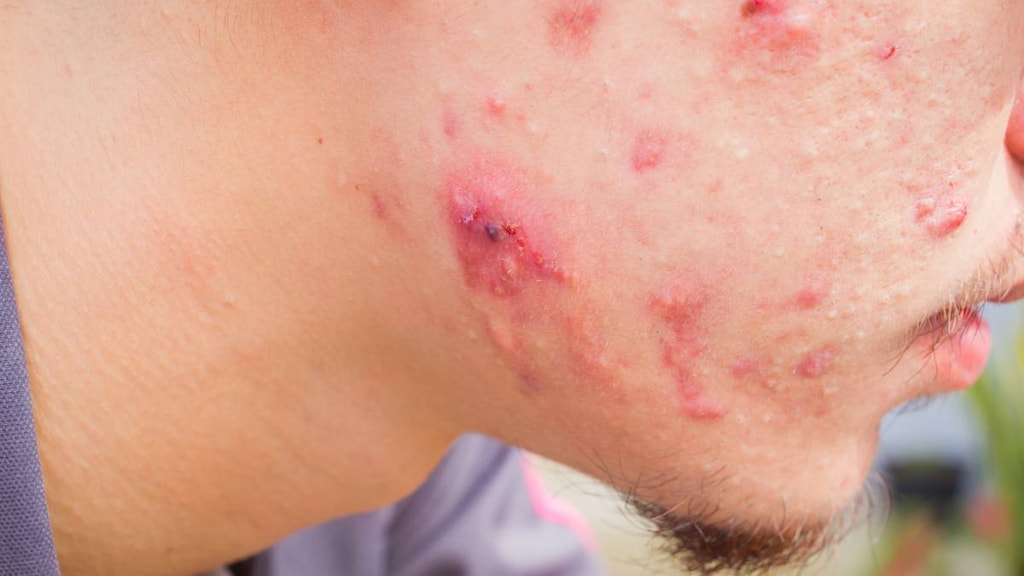Dosage Forms
Excipient information presented when available (limited, particularly for generics); consult specific product labeling. [DSC] = Discontinued product
Gel, External:
Aczone: 5% (30 g [DSC], 60 g, 90 g) [contains methylparaben]
Aczone: 7.5% (60 g, 90 g) [contains methylparaben, polysorbate 80]
Generic: 5% (60 g, 90 g); 7.5% (60 g, 90 g)
Pharmacokinetics/Pharmacodynamics
Absorption
~1% of the absorption of 100 mg tablet
Use: Labeled Indications
Acne vulgaris: Topical treatment of acne vulgaris in patients ≥9 years of age (7.5% gel) or patients ≥12 years of age (5% gel).
Guideline recommendations: American Academy of Dermatology (AAD) acne guidelines recommend dapsone 5% topical gel for inflammatory acne, particularly in adult females with acne (AAD [Zaenglein 2016]).
Contraindications
There are no contraindications listed in the manufacturer's labeling.
Canadian labeling: Hypersensitivity to dapsone or any component of the formulation or container.
Dosage and Administration
Dosing: Adult
Acne vulgaris: Topical: Note: Reevaluate patient if no improvement after 12 weeks of therapy
Gel 5%: Apply pea-sized amount in a thin layer to affected areas twice daily
Gel 7.5%: Apply pea-sized amount in a thin layer to entire face once daily; may also apply a thin layer to other affected areas of the body once daily
Dosing: Geriatric
Refer to adult dosing.
Dosing: Pediatric
Acne vulgaris:
Gel 7.5%: Children ≥9 years and Adolescents: Topical: Apply a pea-sized amount of gel to entire face once daily; may also apply a thin layer to other affected areas of the body once daily; reevaluate patient if no improvement after 12 weeks of therapy.
Gel 5%: Children ≥12 years and Adolescents: Topical: Apply a pea-sized amount of gel to the acne-affected areas twice daily; reevaluate patient if no improvement after 12 weeks of therapy.
Administration
Topical: Clean and dry skin before applying. Rub in gently and completely. Wash hands after applying. Gel may be gritty. For external use only; avoid applying to inside nose, mouth, eyes, vagina, and mucous membranes
Storage
Store at 20°C to 25°C (68°F to 77°F); excursions permitted to 15°C to 30°C (59°F to 86°F). Do not freeze.
Drug Interactions
Antimalarial Agents: May enhance the adverse/toxic effect of Dapsone (Topical). Specifically, the risk of hemolytic reactions may be increased. Management: Closely monitor for signs/symptoms of hemolytic reactions with concomitant use of topical dapsone and antimalarial agents. Patients with glucose-6-phosphate dehydrogenase deficiency may be at particularly high risk for adverse hematologic effects. Consider therapy modification
Benzoyl Peroxide: May enhance the adverse/toxic effect of Dapsone (Topical). Specifically, the use of these agents in combination may cause skin and facial hair to temporarily turn a tan or yellow/orange color. Monitor therapy
Local Anesthetics: Methemoglobinemia Associated Agents may enhance the adverse/toxic effect of Local Anesthetics. Specifically, the risk for methemoglobinemia may be increased. Monitor therapy
Methemoglobinemia Associated Agents: Dapsone (Topical) may enhance the adverse/toxic effect of Methemoglobinemia Associated Agents. Monitor therapy
Nitric Oxide: May enhance the adverse/toxic effect of Methemoglobinemia Associated Agents. Combinations of these agents may increase the likelihood of significant methemoglobinemia. Monitor therapy
Prilocaine: Methemoglobinemia Associated Agents may enhance the adverse/toxic effect of Prilocaine. Combinations of these agents may increase the likelihood of significant methemoglobinemia. Management: Monitor patients for signs of methemoglobinemia (e.g., hypoxia, cyanosis) when prilocaine is used in combination with other agents associated with development of methemoglobinemia. Avoid lidocaine/prilocaine in infants receiving such agents. Monitor therapy
Sodium Nitrite: Methemoglobinemia Associated Agents may enhance the adverse/toxic effect of Sodium Nitrite. Combinations of these agents may increase the likelihood of significant methemoglobinemia. Monitor therapy
Trimethoprim: May enhance the adverse/toxic effect of Dapsone (Topical). More specifically, trimethoprim may increase the risk for hemolysis Monitor therapy
Adverse Reactions
1% to 10%:
Respiratory: Sinusitis (2%)
Frequency not defined:
Central nervous system: Attempted suicide, tonic-clonic movements
Gastrointestinal: Abdominal pain, pancreatitis, severe vomiting
Respiratory: Pharyngitis
<1%, postmarketing, and/or case reports: Application site rash, depression, erythema, erythematous rash, facial edema, lip edema, methemoglobinemia, periorbital swelling, psychosis, skin rash
Warnings/Precautions
Concerns related to adverse effects:
- Dermatologic: Localized discoloration (yellow or orange) of the skin or facial hair may occur if benzoyl peroxide is used subsequent to dapsone gel; typically resolves in ~1 to 8 weeks. Skin reactions (eg, bullous and exfoliative dermatitis, erythema multiforme, erythema nodosum, morbilliform and scarlatiniform reactions, toxic epidermal necrolysis, urticaria) have been reported with oral dapsone; similar events were not observed during clinical trials with topical dapsone.
- Hematologic effects: Changes suggestive of hemolysis have been observed in some patients with glucose-6-phosphate dehydrogenase (G6PD) deficiency and using twice-daily dapsone 5% gel. Discontinue use of dapsone with signs/symptoms of hemolytic anemia. Do not use concomitantly with oral dapsone or other antimalarial agents due to increased risk of hemolytic reactions.
- Methemoglobinemia: Cases of methemoglobinemia, resulting in hospitalization, have been reported with twice-daily dapsone 5% gel. Patients with glucose-6-phosphate dehydrogenase deficiency or congenital or idiopathic methemoglobinemia are at increased risk; avoid use in patients with congenital or idiopathic methemoglobinemia. Dapsone may increase methemoglobin levels, especially in combination with methemoglobin-inducing agents. Signs and symptoms of methemoglobinemia (eg, slate grey cyanosis in buccal mucous membranes, lips, and nail beds) may be delayed hours after exposure; discontinue dapsone treatment promptly and seek immediate medical attention in the event of cyanosis.
- Peripheral neuropathy: Has been reported with oral dapsone; similar events were not observed during clinical trials with topical dapsone.
Concurrent drug therapy issues:
- Drug-drug interactions: Potentially significant interactions may exist, requiring dose or frequency adjustment, additional monitoring, and/or selection of alternative therapy. Consult drug interactions database for more detailed information.
Monitoring Parameters
For patients at risk of anemia, monitor CBC and reticulocyte counts at baseline and routinely thereafter.
Pregnancy
Pregnancy Considerations
The amount of topical dapsone available systemically is minimal compared to oral administration.
Topical products are recommended as initial therapy for the treatment of acne vulgaris in pregnant females; however, information specific to dapsone is lacking (Kong 2013). Agents other than topical dapsone are preferred (Chien 2016).
Patient Education
What is this drug used for?
- It is used to treat pimples (acne).
Frequently reported side effects of this drug
- Skin irritation
- Dry skin
- itching
- Redness
- Peeling
- Oily skin
Other side effects of this drug: Talk with your doctor right away if you have any of these signs of:
- Pancreatitis like severe abdominal pain, severe back pain, severe nausea, or vomiting
- Methemoglobinemia like blue or gray color of the lips, nails, or skin; abnormal heartbeat; seizures; severe dizziness or passing out; severe headache; fatigue; loss of strength and energy; or shortness of breath
- Hemolytic anemia like severe loss of strength and energy, dark urine, or yellow skin or eyes
- Thoughts of suicide
- Severe sore throat
- Back pain
- Abdominal pain
- Severe nausea
- Severe vomiting
- Abnormal movements
- Signs of a significant reaction like wheezing; chest tightness; fever; itching; bad cough; blue skin color; seizures; or swelling of face, lips, tongue, or throat.
Note: This is not a comprehensive list of all side effects. Talk to your doctor if you have questions.
Consumer Information Use and Disclaimer: This information should not be used to decide whether or not to take this medicine or any other medicine. Only the healthcare provider has the knowledge and training to decide which medicines are right for a specific patient. This information does not endorse any medicine as safe, effective, or approved for treating any patient or health condition. This is only a brief summary of general information about this medicine. It does NOT include all information about the possible uses, directions, warnings, precautions, interactions, adverse effects, or risks that may apply to this medicine. This information is not specific medical advice and does not replace information you receive from the healthcare provider. You must talk with the healthcare provider for complete information about the risks and benefits of using this medicine.




